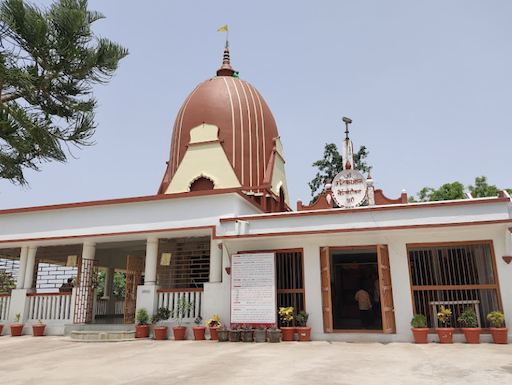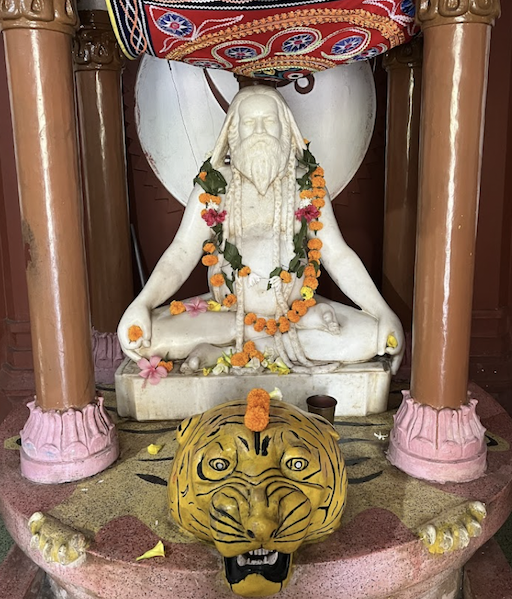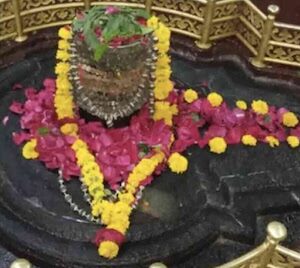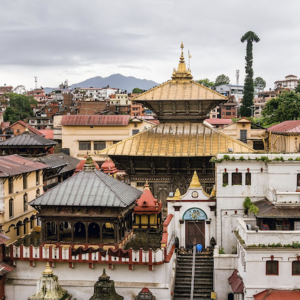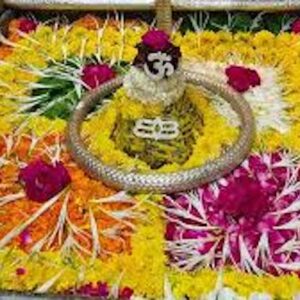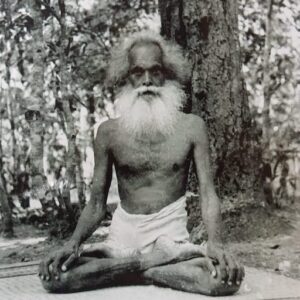This is a Samadhi of Nanga Baba Totapuri Sri Sri Jogeswar Brahmabit Barista Digambar Paramhansh Maharaj in Advaita Brahma Ashram.
There is a place to sit and meditate. You can go into meditative states here effortlessly.
How to get there:
The temple is located 4.1 kms West of Puri Bus Stand.
Map: https://maps.app.goo.gl/KyLg2Q2ezQcgdh7A9
About Totapuri
The ADVAITA Brahma Ashram was established by the tri-centurian ADVAITA Saint, the naked Sanyasi who spent around 40 – 50 years of his last yogic life in Puri. He is famously known as Sri Sri Jogeswar Digambar Paramhansa Maharaj and, in short, Nanga Baba Totapuri or “Nangta” or Languli Baba. The name Totapuri is coined by a combination of “Tota” and “Puri” : when “Tota” was his monastic name “Puri” was the sub caste to which he belonged. Among the Puris he belonged to the “Naga” order of militant ascetics who believed in combating their opponents with the knowledge of sastra. The Sadhu is believed to have led a very long life for more than 300 years. A votary of Naga- Abadhuta cult, he headed the Naga Math ( of Naga Monastery ) in Ludhiana now in the Punjab state. He was basically a “paribrajak” – a wandering monk – of the Dasnami order of Adi Shankar, who had travelled across the Indian subcontinent — the major parts of Brahmadesh ( Bangladesh), and even beyond the Himalayas on foot only. This widely travelled tri-centurian is said to have come in contact with a galaxy of very well- known saints of India like Mahayogi Sri Sri Trailang Swami, the Walking Shiva of Benaras (1607 -1887), the famous tantric saint Sri Bamkhepa of Tarapith ( 1837-1911), Sri Sai Nath of Shirdi (1836 -1918), Swami Nigamananda Saraswati (1880 – 1935) and Sri Ramakrishna Paramhansa (1836 – 1887), etc. Apart from covering all holy places the tri-centurian Nanga Sanyasi also said to have covered the longer courses of the river Sindhu, Ganga, Brahmaputra, Narmada and Godavari and Krishna in the Deccan plateau.
The ADVAITA Brahma Ashram now stands on huge old sand dunes covered with vegetation and greenery with palm, cashewnuts, neem, mango, date palms, casuarina forests presenting a serene atmosphere with flora and fauna of the coastal forests. The place is locally known as Girnarbant. It is said that hundreds of years ago these places were reclaimed after removing the sand by King Galamadhab of Puri. Sri Digambar Sadhu (naked Abadhuta Saint) had earlier preferred to continue his yogic sadhana on the Girnar mountain ranges of Junagadh district of Gujarat, which are considered very sacred to Hindus. His re-appearance on the similar such sand dunes again makes the place known as Girnarbant (bant meaning sand dune). As the revered saint is from ADVAITA Vedant discipline, the Ashram so developed over the sand hill, is known as ADVAITA Brahma Ashram.
Baba belonged to a very rare brand of naked sanyasis of Acharya Adi Shankara lineage of ADVAITA Brahmavad. He was an exponent of Nirvikalpa Dhyana Yoga and Vedantic philosophy. It is said that Baba had witnessed many wars spreading over centuries: Battle of Plassey (1757), Third Battle of Panipat (1761) and the Sepoy Mutiny (1857), besides two world wars (1914-1945).
It is believed that he is the same “Totapuri” Languli Baba, who initiated young Gadadhar Chattopadhyay and transformed him to Sri Ramakrishna Paramhansa. It happened at Dakskhineswar, 6 kilometres north of Kolkata in the year 1864. Totapuri had to guide the young Sanyasi in spiritual practices for eleven months. According to a legend, Baba was in the Himalayas when God directed him to go to Dakshineswar and initiate Gadadhar, the head priest of the Kali temple there. He took the role of Ramakrishna’s mentor and taught him the importance of non-dualistic form of the universe, in other words, the tenets of the ADVAITA Vedanta. In this system, God is understood to be the formless unmanifest energy that supports the cosmos. Totapuri taught his disciple how “Brahman alone is real, and the world is illusory. I have no separate existence, I am that Brahman alone”. Ramakrishna experienced a deep form of trance (nirvikalpa samadhi) under the guidance of Totapuri. This state is described as complete absorption of the soul into the ocean of consciousness.
It is only towards the last 40 to 50 years of his life the “sky clad” wandering Seer set up his hermitage in a terribly isolated place of Girnarvant far from the din and bustle of the township. On the 13th day of moonlit Shravan i.e.28th August 1961, the great Languli Baba attained mahasamadhi (final liberation).
Taught from the early age in the discipline of ADVAITA, His Holiness Nanga Baba Totapuri took the world as an illusion. As an ADVAITAist, a staunch believer in the ADVAITA philosophy called Monism ( Non Dualistic Absolutism) his views were based on a deep study and analyses of the Vedas
A master par excellence in the practice of Nirvikalpa Samadhi Sadhana–a state of Sat-Chit-Anand–and a hollowed master of Atmajnan and Brahmajnan he remains as a living presence in the hearts of millions of his devotees all over the world.
Totapuri & Ramakrishna Paramahamsa
Sadhguru: Ramakrishna Paramahamsa lived as a very intense devotee for most of his life. He was a devotee of Kali. For him, Kali was not a deity, Kali was a living reality. She danced in front of him, she ate from his own hands, she came when he called, and she left him dripping with ecstasy. This was real, it was actually happening. This was not a hallucination, he was actually feeding her. Ramakrishna’s consciousness was so crystallized that whatever form he wished became a reality for him. It is such a beautiful state for a human being to be in. But though Ramakrishna’s body, mind and emotion were dripping with ecstasy, his being was longing to go beyond this ecstasy. Somewhere there was an awareness that the ecstasy itself was a bondage.
One day, Ramakrishna was sitting on the banks of the Hoogli River when Totapuri – a very great and rare yogi, very few like that have ever happened – came that way. Totapuri saw that Ramakrishna was a man of such intensity with the possibility to go all the way and attain enlightenment. But the problem was, he was just stuck to his devotion.
Totapuri came to Ramakrishna and tried to convince him, “Why are you still so attached to your devotion? You have the potential to take the ultimate step.” But Ramakrishna said, “I want only Kali, that’s all.” He was like a child who wanted his mother. It is not possible to reason with that. It is a different state altogether. Ramakrishna was devoted to Kali and Kali was his only interest. When he was high on her, he would be bursting with ecstasy and dancing and singing. When he got a little low, when he lost contact, he would cry like a baby. This was the way he was. So whatever enlightenment Totapuri talked about, he was not interested in all that. In many ways Totapuri tried to instruct him, but Ramakrishna was unwilling. At the same time, he was willing to sit before Totapuri because Totapuri’s presence was such.
Totapuri saw that Ramakrishna was just going on like this. Then he said, “This is very simple. Right now you are empowering your emotion, you are empowering your body, you are empowering the chemistry within you. You are not empowering your awareness. You have the necessary energy but you just have to empower your awareness.”
Ramakrishna agreed and said, “Okay, I will empower my awareness and sit.”
But the moment he has a vision of Kali, he would again go into uncontrollable states of love and ecstasy. No matter how many times he sat down, the moment he saw Kali, he would just fly off.
So Totapuri said, “The next time Kali appears, you have to take a sword and cut her into pieces.”
Ramakrishna asked, “Where do I get the sword from?”
Totapuri replied, “From the same place you get Kali from. If you are able to create a whole Kali, why can’t you create a sword? You can do it. If you are able to create a goddess, why can’t you create a sword to cut her? Get ready.”
Ramakrishna sat. But the moment Kali came, he burst into ecstasy and forgot all about the sword and the awareness.
Then Totapuri told him, “You sit this time. The moment Kali comes…” and he picked up a piece of glass and said, “With this piece of glass, I am going to cut you where you are stuck. When I cut that place, you create the sword and cut Kali down.”
Again Ramakrishna sat and just when Ramakrishna was on the edge of ecstasy, when Kali appeared in his vision, Totapuri took the piece of glass and cut Ramakrishna really deep across his forehead.
At that moment, Ramakrishna created the sword and cut Kali down, becoming free from the Mother and the ecstasy of feeding off her. That is when he truly became a Paramahamsa, he became fully enlightened. Till then he was a lover, he was a devotee, he was a child to the Mother Goddess that he created.
Source:
https://www.advaitbrahmaashram.org/languli_baba.html
https://isha.sadhguru.org/en/wisdom/article/ramakrishna-paramahamsas-enlightenment

